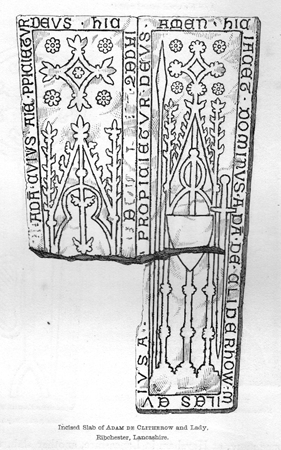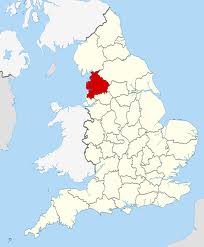 |
LANCASHIRE |
 |
| My home county
although my home town is now in Merseyside, which is not
recognised in the pages! |
|
|
|
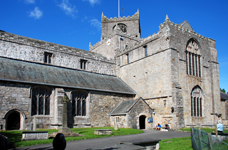 |
Cartmel -
Priory
The Priory Church of St Mary the Virgin at Cartmel |
|
| Cartmel Priory was founded in 1188 by
William Marshall, Earl of Pembroke, as a Augustinian Priory |
 |
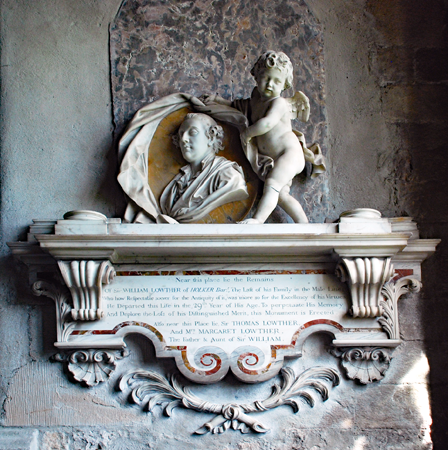 |
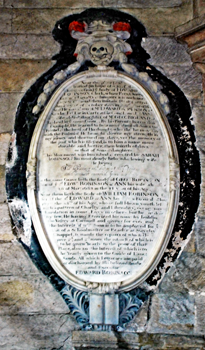 |
 |
| John (1875) Clerk and
Mary (1877) Greenwood. Their daughter, Jane
(1847) aged 13; and their granddaughter, Mary
Jane Greenwood (1858) aged 1 |
Sir Thomas Lowther (1745) |
Edward Robinson (1685),
clerk. His sons by his wife Ann, George Robinson (1683),
and William (167_) |
Christopher Preston (1591)
and his son, John (1579). By his wife Ann
(Benson) the latter had a son, George Preston (1640).
Next George's family are listed and his being a
benefactor to the church |
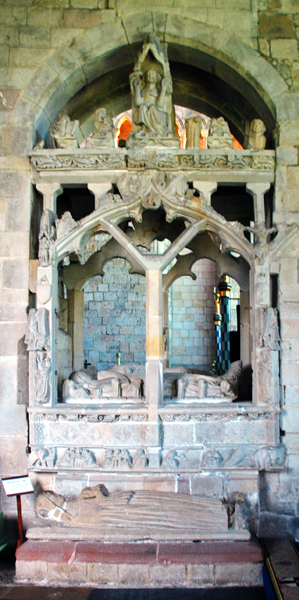 |
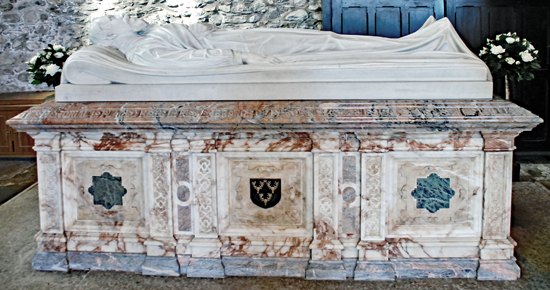
Left:
'The Harrington Tomb isalmost certainly that of
First Lord Harrington (1347) and his wife,
possibly
Joan; their
effigies lie on the tomb chest, he in armour of the time Note the frieze of Bedesmen, crouching and
reading, along the base of the tomb chest, the figures and
shields carved on the supports, and the figure of Christ in
Majesty and other figures atop the canopy. On the other side is
a representation of the Coronation of the Virgin.
Below and in front of the Harrington tomb is the effigy of
a canon on a later tomb chest.
The description of this monument in Pevsner 'The
Buildingsof England: North Lancashire (pp 89-90) is rather
flowery and not particularly helpful. |
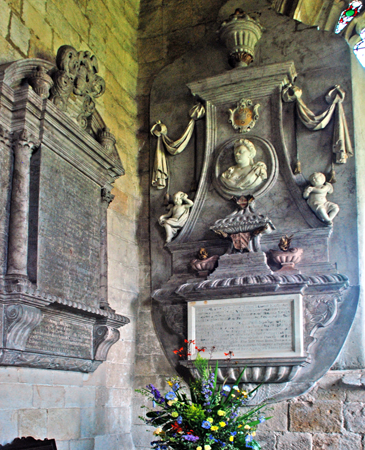 |
Above centre
:Lord Frederick Charles Cavendish (1881)
White marble effigy on alabaster tomb chest, by
Thomas Woolner 1885
Above right: The lettering is intermittently faded here by I can
just about make out Dame Katherine Lowther (1700)
Is this the monument described by Pevsner
(Ibid. P 90)? If so, he also refers to Sir William Lowther
(1705) as well and 'busts' rather than 'bust'. He refers to the
two putti and urn but not to the faming urns etc. I really need
further information before I can interpret this. I cannot
make out the inscription if the tomb on the left, nor is it
referred to in Pevsner. |
| More Monuments |
Prior William of Walton (1292)
Slab
with cross and Lombardic lettering
James Newby (1834)
With a big draped urn, by
Fawcett of Liverpool
Gray Rigge JP & DL
(1857) and his wife,
Sarah (Moore) (1853).
Their eldest son,
Henry Fletcher Rigge JP & DL
(1887). And his son,
Gray Grayrigge JP (1885),
Cpt King's Own Royal Lancaster Reg.
Rosette Margaret
(Machell) Rigge (1905), wife of Henry Fletcher Rigge.
Robert Stockdale
Rigge JP (1820),
son of Gray Grayrigge. Gray Grayrigge (1931),
eldest son of the latter. Lolita (1961)
wife of
Robert Stockdale Grayrigge. Her son, Fletcher Grayrigge
(1967) Large white tablet with arms.
There are several wall monuments about
which I have no information
|
|
|
Didsbury - St
James |
| Didsbury is a suburb of Manchester; St James
in Skinner Lane is the parish church |
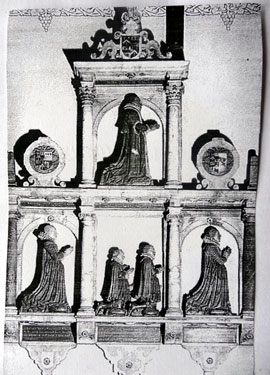 |
Sir Nicholas Mosley (1612)
with two wives (Margaret Whitbroke) and
(Elizabeth Rookes) and two sons, Rowland
& Edward. Alabaster |
|
|
Garstang |
| The parish church of Garstand
- St Helens - is actually at Kirkland; it is a medieval
church. St Thomas, which is in the town, is late 18th
and late 19th centuries. I do not know which of these
the monuments are in. I suspect the incised slab is in
the medieval church and the other monuments in the later
church, but this needs to be confirmed. |
 |
Left: Incised slab with cross, sword and shield
William Bell MD (1870) White ablet with
gable on blsck black base; erected 1882.
'Given in memory of those who died and suffered in the
1984
Abbeystead Disaster, including our friends
Albert and Edna Tomlinson.' Brass.
†
† This was a methane explosion at a water works which
killed sixteen people and injured many more. Remember
methane is what coal miners dread and call fire damp;
it is also what is piped to your house for your central
heating and cooking purposes. |
|
13th century slab with cross, sword and ? |
|
|
Middleton - St Leonard |
 |
 |
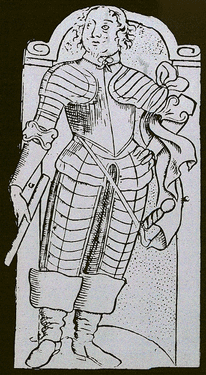 |
| Alice (Assheton) (1531)
originally with her three husbands: Richard Radclyffe,
John Laurence (killed at Flodden), and
Thomas Bothe. There are no children indicated. |
Master Edmund Assheton (1522)
Rector |
Ralph Assheton (1650)
Parliamentary soldier who fought in the Battle of Preston but
opposed the excution of the King |
|
|
|
Warrington -
St Elphin |
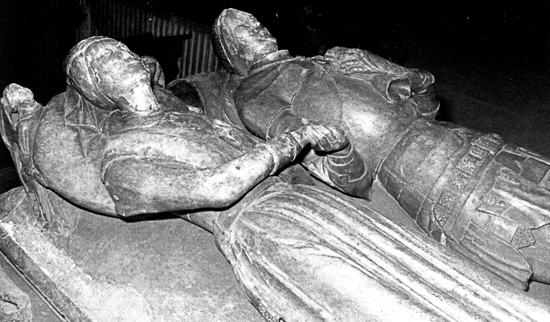 |
| Warrington is a northern industrial town, at
one time the first crossing point of the Mersey, so settled in
early times and with
a medieval parish church. Although on the
north bank of the river it is now in Cheshire. The church is on
the outskirts of town. |
 |
|
Above: Alicia Boteler
Under modern arch, north wall of north chapel. Stone
early 14th century |
Above right:
Sir John Fitzjohn Boteler (1463) and
Margaret Stanley. Alabaster. his feet rest on a dog,
hers on two. Tomb chest is alabaster: north side Holy Trinity,
male saints and shields; south side BVM, female saints and
shields; west side crucifixion, BVM crowned, giving girdle to St
Thomas and angel with shield; east side is a later stone panel
with heraldic motifs.
There are a number of 18 and 19th century monuments for which
information would be gratefully received. |
|
| |
| Thanks to Jean McCreanor and Richard Collyer for sending me the
illustrations and information. The Warrington photographs were taken by
me in the 1980's |
| <Top of Page>
<Gazetteer - Home Page> |
| |
| |













